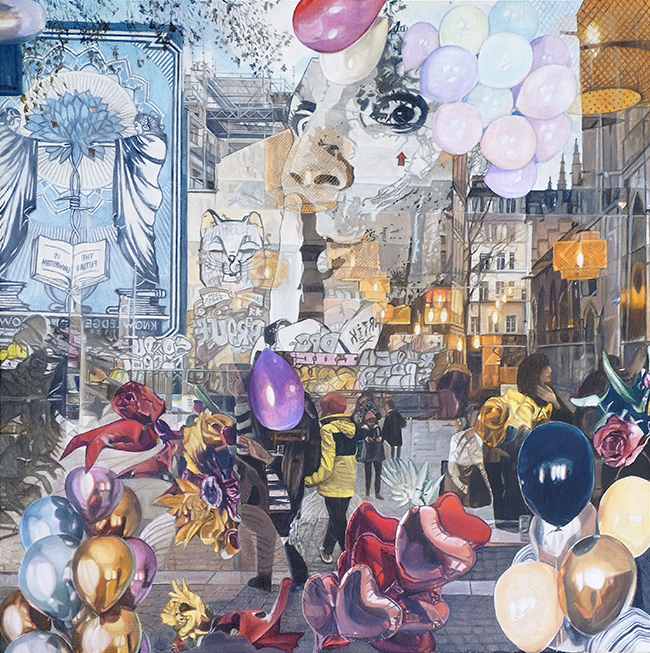Originally hailing from Eastern Europe, Boré Ivanoff has made Paris his home since 2001. A self-taught artist, Ivanoff’s journey in the art world has been nothing short of remarkable. Represented by the gallery “Cygne Noir” in Tours, France, Ivanoff has carved a niche for himself in the vibrant art scene of Europe. Since 2012, he has primarily focused his artistic lens on the enchanting vistas of Paris, weaving its essence into his canvases with deft strokes of his brush.

With an international career spanning several European countries, Ivanoff’s works have found homes in various collections, both public and private. His painting “Cartier Foundation II” earned him a spot in the international exhibition of finalists at the biennial of modern figurative art, Figurativas 23, held at the MEAM Museum in Barcelona.
Ivanoff’s latest creation, unveiled in 2024, bears the intriguing title “Chuuuttt Jef – Stravinsky – Marais.” Painted in oil on linen, measuring 60x60cm, this artwork captures a slice of Parisian life at the iconic Place Stravinsky, nestled next to the Centre Pompidou Museum. Here, amidst the bustling streets, Ivanoff brings to life the vibrant street art frescoes that adorn the walls, including the unmistakable self-portrait of Jef Aerosol, one of France’s most notorious street artists. Ivanoff’s distinctive style infuses the scene with surreal elements, creating a sense of whimsy and celebration. Balloons and flowers dance across the canvas, adding layers of depth and intrigue to the composition.
One of Ivanoff’s greatest strengths lies in his ability to evoke emotion through his art. His paintings of Paris transcend mere representation, offering viewers a glimpse into the city’s soul. Each stroke of his brush tells a story, capturing the essence of Parisian life—the bustling streets, the timeless architecture, and the vibrant street art scene. Through his work, Ivanoff invites us to see Paris through his eyes, to experience its beauty and complexity in a new light.
What inspires your art, and how do you create it?
The City of Lights is the main source of my inspiration. I am one of the few contemporary painters who dare to depict extremely sophisticated and complex, but infinitely fascinating patterns, which are mirrored reflections, captured on urban glass surfaces, The most remarkable and successful artworks that I currently produce are paintings based on a kind of archeology of reflections. The reflections on the Parisian urban glass surfaces are the absolute key element that I look for as imagery which is actually the main catalyst of my paintings and which I would like to share with the world. I use the distortion of reality through reflections as a recontextualization tool this reality. This is why my paintings no longer stick to the irritant conventional representation of a recognizable pattern but are representation of some kind of new ambiguous fiction. Each element interacts with the other and denies any singular reading of the composition and its meaning, focusing the narrative rather on the collective of distorted components and the inevitable interpretation of a new meaning. The structure of the space becomes similar to a poem to the extent that we construct a sentence, a paragraph, a statement, in the timeless and abstract language.
Why do you use a specific medium, and how does it impact your art?
I use the good old classic technique, oil on linen, as a medium. I do this because I simply don’t know how to fabricate my paintings with any other technique and, of course, I see no reason to change that. My paintings absolutely satisfy me and people love them just like that. I think oil painting is the real deal, the highest and noblest medium in painterly image making.
How has your art changed over time, and what influenced those changes?
The ever going change or rather the natural development, or the artist’s evolution, is a constant process with every artist, I think. Martin Kippenberger, the great German artist who is one of my role models, was firmly convinced that “In an art school you could only learn techniques, but that is not art. Everything must emerge from life experience.” “Art is about developing.”, he said. So, in my case every new painting is like I am starting to paint for the first time and through the creative process I am like I re-discover myself and my artistic power, abilities, imagination. So, I suppose that each one of my artworks is a part and a mirror of this evolutionary process of re-birth and re-discovering of myself and my art at the same time. That is the eternal developing based on life experience. Of course, with time, especially since 2016, my artworks became much more sophisticated, maniacal, hypnotic, psychotic and “impossible” in some way, but I am quite happy with this, as longe as I am still so addicted to fabricate them, and I am seeing every day that there are some people that desire to have them as a part of their lives.
How do you want people to feel when they see your art, and what do you expect from their response?
With my recent paintings I am trying to intrigue and surprise my audience, I am focusing on transcribing an unconventional Paris, unexpected, enigmatic, “never seen before”. At the first visual contact with these artworks, the spectator is struck by the enchanting sensation, of a figurative and chromatic chaos, and in the same time he feels intuitively, he is convinced that these artworks have their own aesthetic complexity, ambiguity, paradox, refinement, intelligence, and most important they are a pure representation of an enigmatic unintelligibility. Reflective surfaces are a pure appeal to artists as an expression of modernity. The pluri-reflection is not only a concrete visualization of the author’s level of artistic virtuosity, but it is also a vehicle for his continued exploration of the delicate territory of perception and its visual and spatial translation. The mixture of interior and exterior produces an image whose complexity is almost impossible to disentangle. I’d like my spectator to see my paintings as The Abstract Nature of Reality, as some kind of Psychotic Realism, To feel the beaty of the Controlled Chaos. To get lost at first gaze, then to find his way out from the hypnotic puzzle which are my paintings. I invite the spectator to reconstruct his own version of the deconstructed reality that he sees in my paintings.

